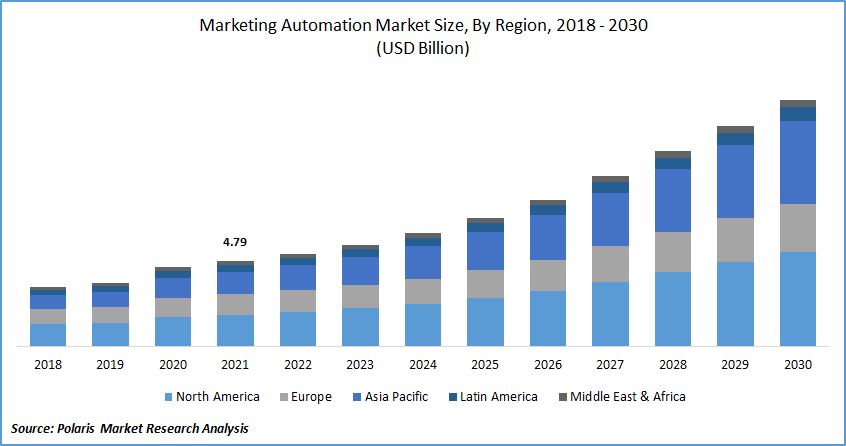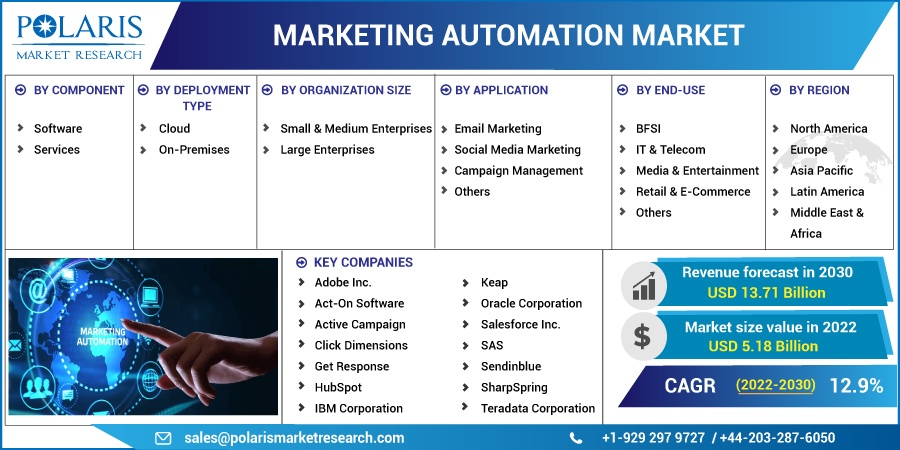
Marketing Automation Market Share, Size, Trends, Industry Analysis Report, By Component (Software, Services); By Deployment Type; By Organization Size; By Application; By End-Use; By Region; Segment Forecast, 2022 - 2030
- Published Date:Oct-2022
- Pages: 101
- Format: PDF
- Report ID: PM2644
- Base Year: 2021
- Historical Data: 2018 - 2020
Report Summary
The global marketing automation market was valued at USD 4.79 billion in 2021 and is expected to grow at a CAGR 12.9% during the forecast period. Marketing automation facilitates the advertising of various products and brands through social media platforms, e-mail marketing, and ad campaigns.
 Know more about this report: Request for sample pages
Know more about this report: Request for sample pages
Likewise, this produces more return on investment as compared to conventional marketing solutions. The industry for automation software consists of several techniques and tools which help to streamline and incorporate social media, content marketing, content marketing, web marketing, and multichannel campaigns.
Marketing automation identifies potential clients and further automates the process of pitching sales leads. This feature provides all the required information to the customers, wherein the salesperson can directly contact the client and explain the further features. This helps the sales team to close the deal within no time. Further, marketing automation has become an important part of company structures. With the increasing purchases of IoT-connected devices, there has been an expansion and evolvement in the usage of such automation processes.
Moreover, marketing automation also improves the productivity of the sales funnel and provides customer satisfaction as well by providing all the details promptly. In addition, marketing automation also helps in knowing the potential customer behavior through its behavioral tracking approaches. This tracks the information the customer has fed during the initial search, which further helps in understanding the interest and purchasing lifecycle.
The COVID-19 pandemic positively influenced the global marketing automation market and its opportunities. There has been a transitional change across various fields, such as marketing, advertising, and publicity. The rise in marketing budgets during the pandemic supported industry growth.
 Know more about this report: Request for sample pages
Know more about this report: Request for sample pages
Industry Dynamics
Growth Drivers
The global marketing automation market is driven due to rise in the adoption of marketing automation platforms and growth in adverting and social media. Moreover, the development of SaaS-based solutions has also created an opportunity for the industry. Small firms and other companies seek fewer capital investments and greater flexibility. Several suppliers have started to provide their software as a service to get a foothold on the low end of the industry.
Adobe Systems process around 90 trillion data transactions per year through the company’s SaaS products. Also, the lack of skilled employees hinders the industry's growth to a certain extent. However, investing in better training & development activities for the employees for handling the marketing automation software is highly opportunistic for the industry.
Report Segmentation
The market is primarily segmented based on component, deployment type, organization size, application, end-use, and region.
|
By Component |
By Deployment Type |
By Organization Size |
By Application |
By End-Use |
By Region |
|
|
|
|
|
|
Know more about this report: Request for sample pages
Software segment dominated the global marketing automation market
This is due to the growing adoption of innovative technologies, such as machine learning, artificial intelligence, and cloud computing, among others. This has further led to an increase in demand for marketing automation software and services. Hence, the rising willingness to computerize and augment advertising methods stimulates the growth of marketing automation software.
Cloud segment expected to exhibit significant growth during the forecast period
Cloud-based solutions are expected to trend during the forecast timeline owing to the simple, secure functioning and scalability that this deployment type offers. However, the on-premises solution is considered to be more secure, as the entire software remains on the organization’s premises.
Large enterprises segment generated significant revenue in 2021
The large enterprises segment accounted for a significant share in 2021. There has been an increased demand for innovative technologies such as machine learning and artificial intelligence within marketing automation software by large enterprises. Large enterprises are much more open to adopting innovative and developing technologies for capturing bigger audiences for higher efficiency and performance.
Social media marketing accounted for the largest share in 2021
The social media marketing segment is expected to account for the largest share during the forecast period. IT organizations are increasingly investing in data & analytics systems in the industry. Further, the adoption of predictive algorithms helps make better marketing decisions. Moreover, the integration of these algorithms onto social media platforms is expected to lead to powerful monetization methods.
IT & Telecom industry accounted for the largest share in 2021
Marketing automation helps companies to analyze their brand image among customers. It helps IT & telecom companies to strategize their marketing efforts. For instance, Sprint Corporation, an American-telecommunications holding company, witnessed a decline in its stock due to poor service post its merger with Nextel.
Sprint Nextel then revamped its social engagement programs and announced new social media policies that positively impacted the company’s financial status. Analysis of brand audience interactions and customers that intend to make a switch between brands is expected to drive the industry in the IT & telecom industry.
Asia Pacific region is expected to witness highest growth rate during the forecast period
Asia Pacific is expected to witness exponential growth in the marketing automation industry owing to the increasing usage of digitalization in countries such as China, India, Japan, Singapore, and others.
Apart from having one of the largest Internet bases in the world, China also has the most active environment for social media as compared to other countries. China has banned social networking websites such as Facebook & Twitter and uses Sina Weibo, which has become one of the most popular sites in the country with millions of daily users.
Also, with the increase in digitalization in India through the ‘Digital India’ campaign, India has witnessed a digital revolution. Further, the country has also witnessed proliferated growth in internet penetration and e-commerce that has greatly impacted the industry growth in India.
Competitive Insight
Some prominent companies operating in the global market include Adobe Inc., Act-On Software, ActiveCampaign, ClickDimensions, GetResponse, HubSpot, IBM Corporation, Keap, Oracle Corporation, Salesforce Inc., SAS, Sendinblue, SharpSpring, Teradata Corporation, and Thryv.
These major industry players involved in the global marketing automation market are investing in research and development and technological advancements to enhance their offerings in the industry and serve their customers in an efficient manner. Various strategies such as collaborations, acquisitions, and mergers offer opportunities for strengthening market position, entering new developing markets and widening customer base.
Recent Developments
In September 2021, Oracle Corporation launched a new and innovative system named Oracle Fusion Marketing System. This system automates essential element of digital marketing campaigns with the help of artificial intelligence (AI).
In January 2020, IBM Corporation increased their product portfolio by announcing the launch of Advertising Accelerator with Watson. With the help of artificial intelligence technology, Watson aimed to create digital marketing campaigns, which are eye catching and engrossing to the customers.
Marketing Automation Market Report Scope
|
Report Attributes |
Details |
|
Market size value in 2022 |
USD 5.18 billion |
|
Revenue forecast in 2030 |
USD 13.71 billion |
|
CAGR |
12.9% from 2022 - 2030 |
|
Base year |
2021 |
|
Historical data |
2018 - 2020 |
|
Forecast period |
2022 - 2030 |
|
Quantitative units |
Revenue in USD billion and CAGR from 2022 to 2030 |
|
Segments covered |
By Component, By Deployment Type, By Organization Size, By Application, By End-Use, By Region |
|
Regional scope |
North America, Europe, Asia Pacific, Latin America; Middle East & Africa |
|
Key companies |
Adobe Inc., Act-On Software, ActiveCampaign, ClickDimensions, GetResponse, HubSpot, IBM Corporation, Keap, Oracle Corporation, Salesforce Inc., SAS, Sendinblue, SharpSpring, Teradata Corporation, and Thryv. |
License and Pricing
Purchase Report Sections
- Regional analysis
- Segmentation analysis
- Industry outlook
- Competitive landscape
Connect with experts
Suggested Report
- Slider Bags Market Share, Size, Trends, Industry Analysis Report, 2023 - 2032
- Crypto Wallet Market Share, Size, Trends, Industry Analysis Report, 2022 - 2030
- Vessel Sealing Devices Market Share, Size, Trends, Industry Analysis Report, 2022 - 2030
- Maternity Innerwear Market Share, Size, Trends, Industry Analysis Report, 2021 - 2029
- Automotive V2X Market Share, Size, Trends, Industry Analysis Report, 2022 - 2030

